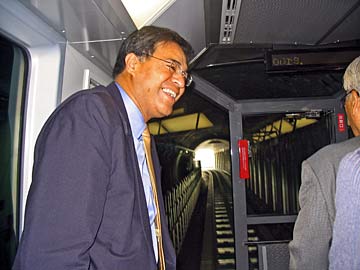
CRYSTAL KUA / CKUA@STARBULLETIN.COM
Mayor Mufi Hannemann stood aboard the Linimo magnetic levitation train in Nagoya last week as the car got ready to come out of an underground section.
|
|
Mayor upbeat on rail after Japan tour
TOKYO » When the City Council took up legislation this summer to increase the general excise tax to pay for mass transit, a man carrying a recorder came up to the microphone and played the tape.
ON ASSIGNMENT
 Star-Bulletin reporter Crystal Kua is traveling with Mayor Mufi Hannemann and the Honolulu delegation.
Star-Bulletin reporter Crystal Kua is traveling with Mayor Mufi Hannemann and the Honolulu delegation.
|
"Someone had the loud noise of the train," Council Chairman Donovan Dela Cruz recalled. But after touring three train systems in Japan this past week, Dela Cruz said that he now knows what was on the tape isn't necessarily what modern mass transit sounds like.
"What we rode today made no noise at all," Dela Cruz said Friday after riding a train system that used magnetic levitation. "Even when we were in the conference room, trains were passing all the time and no one blinked. No one even heard it."
Dela Cruz and others who accompanied Mayor Mufi Hannemann to Japan say after seeing these systems first hand and riding on them, they are better prepared to make a decision on what transit system is best for Honolulu.
"Now I have living concrete examples to point to that I didn't have before I entered into this trip that showed where the technology is working, that it can be environmentally friendly, that the noise factor can be dealt with, and it can be done quickly," Hannemann said.
But Sen. Sam Slom, an opponent of rail, said there's more to consider than technology.
"The whole thing really comes back to who's going to make the money, who's going to benefit from this," he said. "Rather than focusing on technology, we should be focusing on what the total cost will be, what the routes will be, what kind of environmental damage will be done, what kind of eminent domain will be necessary."
He also said there are less expensive and easier alternatives to rail, including lane additions and new roadways.
Hannemann, though, said that one of the themes that he came away with from the trip is that Japan gives its people options in how they get around the city -- whether it's by train, cars, taxi cabs or bicycles.
"We definitely learned a lot. We've been to cities on the mainland and there's no doubt that Japan is far ahead. Even their technology from 10 years ago is still head of the United States," Dela Cruz said. "And, they're always looking at how they can keep improving it."
Hannemann also said that he has also learned not to prejudge anything.
For example, he went on the trip nearly discounting an elevated train system for Oahu, but after seeing the systems, he doesn't think that way anymore.
"I saw with all three systems the advantages if you go elevated and I don't think it necessarily blocks the view planes," Hannemann said. "If you're a rider, it definitely enhances your view planes and your appreciation for the city that you live in."
Hannemann said he is even more motivated to get a rail system built quickly because he knows it can be done.
"I want this thing done quickly -- go through the basis, do what we need to do to get eligible for federal funding, do the environmental impact statement, but I don't want to be sitting around twiddling our thumbs," Hannemann said.
Hannemann said that so far he hasn't seen anything to sway his thinking yet when it comes to taking a rail system underground.
"It's just too costly to go underground," he said, with the Japanese confirming that costs rose when they went below ground.
Dela Cruz said that the systems he toured this week reaffirmed his belief that the rail line brought economic development, urban renewal and increased ridership as people got used to the rail line.
"You really have to look at the overall picture of planning," Dela Cruz said. "This fulfills our vision of Kapolei becoming a second city and this also fulfills our future plans for increased development in the primary urban corridor."
He also said he saw first hand how a rail line can be part of an overall transportation network with other feeder systems.
Both Hannemann and Dela Cruz said they will now take what they learned back to other city officials and the public.
Star-Bulletin reporter Mary Vorsino contributed to this story.

